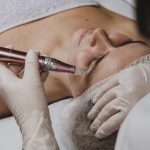Following a chemical peel, it’s natural to anticipate noticeable peeling or flaking as a visible sign that the treatment is working. Therefore, when the skin remains smooth and does not appear to have changed in the days following treatment, it can be frustrating. It’s simple to make the mistake of believing that if there is no peeling, no improvement is being made. But that isn’t always the case.
Peeling is a possible response to a chemical peel and not a definitive sign of success. The providers at NorthWest Face & Body recommend paying attention to how your skin feels and functions in the days and weeks after treatment, rather than expecting visible peeling. This guide will walk you through what chemical peels do, how they work beneath the surface, and why flaking doesn’t always occur.
How Chemical Peels Work
A chemical peel is a non-surgical cosmetic procedure in which a solution composed of gentle, skin-safe acids is applied to your face or other areas of the body. When applied, the acid solution peels away the surface layer of your skin and stimulates new cell turnover below the surface.
Here’s what a chemical peel can help with:
- Uneven skin tone and texture
- Fine lines and wrinkles
- Hyperpigmentation and sun spots
- Acne and clogged pores
- Dull and tired-looking skin
Why Peeling Doesn’t Always Occur
Visible peeling is commonly misunderstood as the mark of success following a chemical peel, but peeling is rather a side effect. The main aim is to stimulate cellular turnover, enhance skin tone, and create texture refinement.
Type and Duration of the Peel
- Light/superficial peels (e.g., lower concentrations of glycolic, lactic, or salicylic acids) are formulated to exfoliate lightly. They address the outermost layer of skin and usually don’t make peeling noticeable.
- Medium and deep peels, like those with higher concentrations of trichloroacetic acid (TCA) or phenol, usually produce more dramatic flaking.
Skin Prepping and Daily Routine
If the skin is well-exfoliated to begin with, perhaps due to retinoids, AHAs, or BHAs used during the preceding weeks, it might not peel much. The upper layers are already healthy and thin, so the peel speeds up internal re-growth.
Individual Skin Response
Skin thickness, oil production, hydration levels, and even genetics may affect how evidently the skin responds. Certain skin types exfoliate more gently, even after the same treatment that results in dramatic peeling on others.
Environmental and Post-Peel Conditions
Humidity, using heavy moisturizers, or cold climates may reduce visible peeling. Adequate post-peel hydration can also ensure the skin barrier is intact enough that it doesn’t flake.
What’s Happening Beneath the Surface
Even when there isn’t peeling to be seen, the skin is still changing:
- Dead cells fall off: This unseen exfoliation removes dead skin cells from pores, smooths out texture, and lightens skin.
- Cell turnover is speeding up: The peel encourages your skin to force newer, healthier cells to come to the surface faster.
- Collagen formation can be stimulated: Particularly in medium or deeper peels, the injury triggered by the peel stimulates repair mechanisms that tighten and thicken skin in the long term.
- Regulated Pigmentation: Peels also break up clusters of melanin and can enhance the look of dark spots and uneven skin tone, even without peeling.
In other words, lack of peeling doesn’t equate to a lack of progress. Most light to moderate chemical peels are formulated with no downtime in mind.
Aftercare Tips When Your Skin Doesn’t Peel
Even if there is no flaking to see, good aftercare is needed to help your skin heal, keep barrier function healthy, and optimize your chemical peel results. Simply because it’s occurring more quietly doesn’t mean your skin isn’t working hard below the surface. Here are some of the aftercare tips advised by the healthcare providers at NorthWest Face & Body:
Keep Your Skin Hydrated
Maintain your skin comfortably moist with a mild, fragrance-free moisturizer. Apply moisturizers that contain ingredients such as ceramides, hyaluronic acid, glycerin, or squalane. These restore the skin barrier without clogging pores.
Don’t Touch the Treated Area
Avoid picking, scrubbing, or exfoliating to try to make it peel. It can interfere with the healing process of your skin and cause irritation, redness, or even pigmentation.
Pause Active Ingredients
Steer clear of retinoids, alpha-hydroxy acids and beta-hydroxy acids (AHAs/BHAs), and high-strength vitamin C products for a minimum of 3–5 days, longer if your practitioner advises. These can overstimulate newly treated skin and lead to unnecessary sensitivity.
Protect Your Skin from UV Rays
Post-peel skin is more vulnerable to sun damage, even when it’s not visibly shedding. Apply a broad-spectrum sunscreen with SPF 30 or higher every morning, even indoors, and reapply if you’re exposed to direct sunlight.
Stick to Gentle Products
Use a mild, pH-balanced cleanser and skip products with alcohol, essential oils, or artificial fragrance. Keep your routine simple: cleanse, hydrate, protect.
Watch for Delayed Peeling or Sensitivity
Some light peels may result in delayed flaking a couple of days later. If so, handle it gently. If redness or sensitivity lingers for more than a week, see your provider. With good care, your skin will only get better, whether or not it peels. Have faith in the process, be consistent, and be patient with your skin.
If you still have questions related to chemical peels or are ready to schedule your treatment, give us a call at (425) 472-1046 or book an appointment online.
Conclusion
Lack of observable peeling after a chemical peel isn’t an indication of failure; it’s just one of the normal reactions to treatment. Although peeling may seem like verification, it is not. Even when the skin is not flaking or shedding, it is still making critical changes.
Each individual’s skin reacts uniquely depending on variables like peel strength, skin type, environmental variables, and previous skincare routine. The secret to a successful post-peel experience is to believe in the process and take care of your skin.
Further readings






